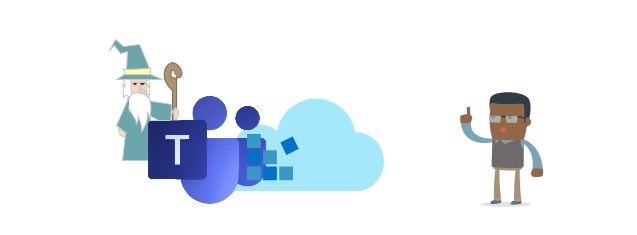This post was most recently updated on April 23rd, 2025.
3 min read.As Teams adoption grows (partially driven by the megatrend of digitalization, partially by the massive surge in working from home due to Covid-19), different problems managing Teams also become more obvious. The growth seems to have been largely organic. Teams and organizations are adopting the tools that best help them get their work done with little regard to how the tools are maintained and best used.
Teams are often created as needed, and by whoever needs them. The creator also becomes the owner – often, the sole owner – of the team. But what if they leave the organization?
Their teams become orphaned, and there’s very little any of the members can do to administer the team. For teams that are actively in use, being unable to add new members, configure new channels, or register new apps might completely cripple them.
This makes orphaned teams a pretty big problem.
Oh – by the way. If you’re working from home, check out my top tips for staying sane from the article below:
What to do, then?
Teams are actually powered by the Office Groups, and the permission model (for the time being, at least) is also coming straight from the Groups. Office Group members are also members of the Teams team, and Office Group owners are also owners of the Teams team.
Hence, the fix is pretty much the same as for just the “vanilla” Office Groups. I’m describing the scripted solution in this article, but you can also check a longer description of pretty much the same script in the article below:
However, since the terminology and the use case is just a bit different, I’m describing the steps also below!
Solution
You can use PowerShell to add a new owner to an “unified group” – which is the name Exchange Online uses for Office Groups, which in turn power the permissions for Microsoft Teams -teams.
Don’t want to read through the whole thing? I’ve got a full script ready for you. Just jump to the script by clicking this!
Time needed: 10 minutes
How to add a new Owner to a Microsoft Teams team using PowerShell
- Open Powershell (don’t use SharePoint Online Management Shell)
At least I had to run it as an admin. Don’t use SharePoint Online Management Shell – you never know if some of the imported commandlet names might conflict!
- Store your credentials
$cred = Get-Credential
This opens a login window, where you can give your admin credentials. - Establish a session with Exchange Online
$session = New-PSSession -ConfigurationName Microsoft.Exchange -ConnectionUri https://outlook.office365.com/powershell-liveid/ -Credential $cred -Authentication Basic -AllowRedirection
The ConnectionUri is the same for all tenants! Don’t change it.
Then import the established session:Import-PSSession $session
Executing this command should actually take a while, as PowerShell is importing a lot of commandlets here. After it’s done, you are able to run the next command. If you aren’t, you’ll need to make sure you have enough permissions on the account you’re using! - Figure out the alias of your group (you’ll need it in a sec)
Running something like this gets you only the “orphaned” groups (without a single owner). Exchange Online calls Office Groups UnifiedGroups. That might be a bit confusing, but it’s very fitting for their role as the one, unifying the access to all different Microsoft tools in Office 365!
$Groups = Get-UnifiedGroup | Where-Object {([array](Get-UnifiedGroupLinks -Identity $_.Id -LinkType Owners)).Count -eq 0} | Select Id, Alias, DisplayName, ManagedBy, WhenCreated
ForEach ($G in $Groups) {
Write-Host “Warning! The following group has no owner:” $G.Alias
}
This magic command shows only the Office 365 Groups without Owners. In this case, there’s just one, and its properties are shown nicely. - Add your account (or any other) as a member of the group, then as the owner
This order of commands is required – only members can also be owners! See the commands below – they’ll yield no output if successful:
Add-UnifiedGroupLinks [alias_from_above] -Links [your_upn] -LinkType Member
Add-UnifiedGroupLinks [alias_from_above] -Links [your_upn] -LinkType Owner - Verify, that the operation was successful
You can verify the success by querying for your group:
Get-UnifiedGroup -Identity [alias_again] | Select Alias,ManagedBy
This should produce your group with your account in the “ManagedBy” column.
Alternatively, of course, you can just query all orphaned groups again!
The End Game: Add yourself as the owner of all orphaned groups
So, taking what we’ve learned today, in short, this is the script you can use to add yourself as the owner of all the orphaned Office 365 Groups:
$cred = Get-Credential
$session = New-PSSession -ConfigurationName Microsoft.Exchange -ConnectionUri https://outlook.office365.com/powershell-liveid/ -Credential $cred -Authentication Basic -AllowRedirection
Import-PSSession $session
$groups = Get-UnifiedGroup | Where-Object {([array](Get-UnifiedGroupLinks -Identity $_.Id -LinkType Owners)).Count -eq 0} | Select Id, Alias, DisplayName, ManagedBy, WhenCreated
ForEach ($g in $groups) {
Add-UnifiedGroupLinks $g.Alias -Links $cred.UserName -LinkType Member
Add-UnifiedGroupLinks $g.Alias -Links $cred.UserName -LinkType Owner
}
Hope this helps :) As usual, I welcome any and all feedback in the comments -section below!
- Am I the problem? Even onboarding to the Apple ecosystem failed miserably. - July 8, 2025
- Any kubectl command throws “Unhandled Error” err=”couldn’t get current server API group list: Get \”http://localhost:8080/api?timeout=32s\”: dial tcp [::1]:8080: connect: connection refused” – what do? - July 1, 2025
- “Sync error. We are having trouble syncing. Click ‘Sign in again’ to fix the issue.” in OneNote? Let’s fix it! - June 24, 2025



